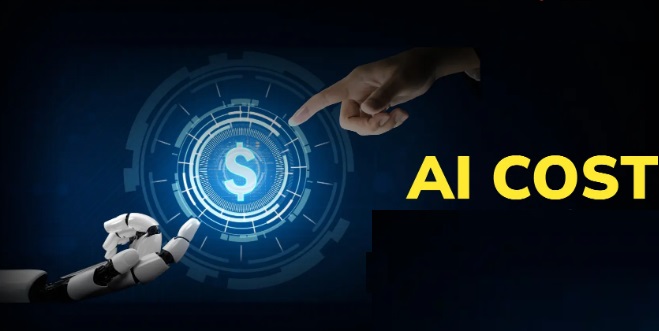Stories you may like
Cost of Implementing Artificial Intelligence
The demand for artificial intelligence continues to grow as organizations across industries strive to optimize business processes, improve customer experiences, and drive innovation. But one question consistently arises: How much does it cost to implement AI? The cost of implementing artificial intelligence can vary drastically depending on several factors including the type of AI, scope of the project, data availability, and level of customization required. Understanding the ai cost landscape is essential for any business planning to invest in this transformative technology.
1. Understanding The True AI Cost
The total cost of AI goes far beyond simply purchasing AI software. It involves multiple components such as data collection and labeling, infrastructure setup, AI model development, testing, deployment, and ongoing maintenance.
The cost of implementing AI can range from tens of thousands to millions of dollars, depending on the scale. For a basic chatbot or predictive analytics tool, you might spend $20,000 to $50,000. For large-scale AI systems that require generative AI, real-time processing, and custom AI development, costs can exceed $500,000.
The AI investment should be guided by clear objectives, expected ROI, and how well the AI aligns with overall business needs.
2. Key Factors That Influence The Cost Of AI
Several elements determine how much an AI project will cost:
Complexity of the AI Model
More advanced AI systems—especially those that include deep learning, generative AI, or real-time natural language processing—require more time and expertise to develop, which adds to the project cost.
Type of AI Solution
The cost of AI differs by type of AI: a custom AI solution will cost significantly more than adopting a prebuilt AI platform or using plug-and-play AI tools.
Infrastructure and Data
AI infrastructure, such as GPUs for training, cloud computing resources, and secure storage, adds substantial cost. Similarly, acquiring and curating quality data—necessary for training AI algorithms—can be resource-intensive.
AI Development Team
Hiring AI developers, AI engineers, and data scientists—either in-house or through agencies—directly influences the ai development cost. Highly skilled AI professionals are in demand, and the cost of hiring them can significantly increase the cost of developing AI.
3. Average Cost Of Developing An AI Solution
If you’re asking, How much does artificial intelligence cost?—here’s a basic overview of average costs based on project scale:
- Simple AI applications (e.g., recommendation engines or chatbots): $20,000 – $50,000
- Medium-scale AI systems (e.g., fraud detection, AI-powered CRMs): $50,000 – $150,000
- Enterprise-grade AI solutions (e.g., custom AI development, predictive modeling, computer vision): $200,000 – $1 million+
These estimates include AI software development cost, training AI models, AI infrastructure, and initial AI implementation.
The cost of developing AI increases with the complexity of the AI model, amount of training data needed, and the level of integration with existing business processes.
4. AI Software Development Cost And Hidden Expenses
The AI software development cost encompasses more than just writing code. It includes:
- Designing the AI solution
- Model development and training
- Testing and validation
- Data collection and preparation
- Deployment and scaling
- Monitoring and maintenance
Additionally, there are hidden costs associated with AI:
- Ongoing model retraining
- Version upgrades of the AI system
- Licensing fees for using third-party AI frameworks or APIs
- Compliance and data protection to meet regulatory standards
- Support services for end users
Failing to account for these factors during cost estimation can lead to inaccurate budgeting and implementation costs spiraling out of control.
5. AI Infrastructure: A Critical Cost Component
A robust AI infrastructure is foundational to successful AI development. This includes high-performance computing hardware, cloud-based resources, and secure networking capabilities. Large-scale AI requires massive compute power and high memory GPUs, which can cost thousands per month for cloud access alone.
Building the AI solution internally often requires investments in:
- Data storage systems
- Data pipelines
- Security architecture
- Monitoring tools
Companies that lack these resources may need to rely on third-party vendors or AI services, which adds another layer of AI investment.
6. Cost Of AI Across Different Use Cases
The cost of AI development also depends on the use cases. For example:
- Healthcare AI applications for analyzing medical images can cost more due to regulatory requirements and model precision needs.
- Driverless cars and autonomous vehicles involve real-time AI algorithms, sensor data integration, and safety layers, making them some of the most expensive applications.
- Generative AI tools like image or text generators require complex model training and vast data sets, which leads to high costs.
- AI for cybersecurity or finance may be less expensive but still involve high AI training and testing costs due to sensitivity.
These different types of AI require different levels of customization, validation, and AI frameworks, all of which affect the development cost.
7. Estimating The Cost Of An AI Project
Artificial intelligence cost estimation is both a technical and business process. A proper cost estimation should include:
- Scope definition: What problem is the AI solution solving?
- Data availability: Do you have access to clean, labeled data?
- Technology stack: What AI frameworks, cloud services, and APIs will be used?
- Manpower: How many AI engineers and data scientists are required?
- Timelines: Longer timelines usually lead to higher cost of developing and maintaining the system.
Companies must also factor in the cost of integrating AI with existing platforms and the effort required for change management and training employees to use AI applications.
8. AI Investment Vs. Long-Term Cost Savings
While the cost of artificial intelligence implementation can be high, the benefits of AI in the long run may far outweigh the initial investment. When done correctly, AI to optimize business operations can lead to:
- Reduced labor costs through automation
- Faster decision-making through real-time analytics
- Improved customer experience
- Enhanced cybersecurity and fraud detection
- Better product recommendations and personalization
Strategic AI adoption with a well-planned AI strategy can lead to substantial cost savings, improved efficiency, and competitive advantage.
Conclusion
The cost of implementing artificial intelligence depends on numerous factors including the type of AI, project complexity, infrastructure needs, and the scale of deployment. Whether you’re developing an AI system from scratch or customizing existing AI software, you’ll need to account for development cost, infrastructure, personnel, and long-term maintenance.
Asking how much does AI cost or how much does artificial intelligence cost has no simple answer. A small AI app development may cost $20,000, while enterprise-grade AI projects may exceed a million dollars. What’s clear is that the AI investment must align with your organization’s goals, capabilities, and willingness to innovate.
With thoughtful planning and realistic cost estimation, AI development can unlock powerful transformation. But understanding the total cost of AI is essential before embarking on any AI initiative—because AI being used wisely starts with knowing what it takes to build it well.






User's Comments
No comments there.